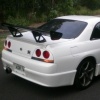R33 Rb30 Conversion
Announcements
-
Similar Content
-
Latest Posts
-
By TurboTapin · Posted
Yes, I had ordered the spherical bushings at the same time as the rest. I have high hopes for the anti squat reduction kit. -
Make sure you use the spherical bushes** on the lower arms, ifyou do that. ** at least, if not the whole replacement lower arm.
-
The tap for coolant flow control will be stuck open. It's not just the air door motor that dies.
-
Not really, but the heater box is pretty simple mechanically....if the door is one way the air bypasses the heater core and if it is the other way it goes through it for warm air. If you are sure the actuator you moved manually is for the heater mix (there would also be one for output air direction) then I'd take the heater box out and see what is happening (you'll have to regass and re-coolant the systems afterwards) BTW pp724 onwards from the GTR workshop manual cover the system in good detail, it is probably worth checking. I think the IAT sensor might be a problem electrically for getting cold (if you got 24 error code not -24 it thinks the incoming air is -50c) and it covers how to test the sensor (although most likely it is either not plugged in or a wire is damaged)





Recommended Posts
Create an account or sign in to comment
You need to be a member in order to leave a comment
Create an account
Sign up for a new account in our community. It's easy!
Register a new accountSign in
Already have an account? Sign in here.
Sign In Now